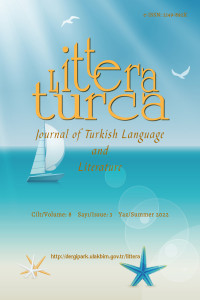NEDÎM TAKİPÇİLİĞİNDE ÖNEMLİ BİR EŞİK: SEYYİD VEHBÎ’DE ŞUHÂNE TARZ
Klasik şiirde şuh söylemin başlangıçtan itibaren pek çok şair tarafından kullanıldığı görülmektedir. Dehhânî ile başlayan bu kullanımlar, güçlü şairler elinde geliştirilse de Nedîm bu tarzı bir ekol hâline getirmiştir. Nedîm ise bu tarzı en güzel şekilde terennüm edip takipçilerine ulaştırmıştır. Şuhane tarzda şiirler yazan Seyyid Vehbî de bu üslubu, Nedîm’i aratmayacak bir söylemle kullanarak bu tarzın önemli takipçisi olmuştur. Vehbî; sevgiliyi gümüş göğüslü, âşığına nazik davranan ve sınırsızca buse veren, naz yapmayan, kucaklanan, âşığının hanesine gelerek onu mutlu eden, balık etli, kiraz gibi yanakları ile gayet cazibeli, hamamda tenini görünür kılacak derecede pervasız tavırlı olarak resmeder. Bu betimlemeler şuhtur. Bu sevgili ayrıca; yürüyüşü, tavrı, tabiatı yanında, mahremiyetini ifade eden fiziksel cazibesi, şarap gibi mest eden dudakları ve kıyametler koparan tıfıl niteliği ile Nedîm’in meşrebine uygun bulduğu sevgililerine de benzemektedir. Vehbî, Nedim’den miras aldığı bu söylemi ilerletmede gayet başarılı olmuştur. O, bu nedenle Nedîm takipçiliğinde bir eşik konumundadır. Makalede şairin bu konumu şuh sevgili, vuslatın şuh terennümü, şarap-sevgili birlikteliği ile şaraba atfedilen şuhluk ve hamam imajı çerçevesinde sevgilinin şuh terennümü gibi dört başlık altında şuhane tarzın ilkeleri bağlamında incelenmiştir. Bu
An Important Threshold in Following Nedim: Suhana Style in Sayyid Vehbi
It is seen that the suh discourse in classical poetry has been used by many poets from the beginning. Although these uses, which started with Dehhânî, were developed in the hands of powerful poets, Nedîm turned this style into a school. Nedim, on the other hand, express gently this style in the best way and conveyed it to his followers. Seyyid Vehbî, who wrote poems in this style, also became an important follower of this style by using this style with a discourse that is equally good like Nedim. Vehbi depicts the beloved with a silver breast, who treats her lover kindly and gives unlimited kisses, who does not feign reluctance, who can be embraced, who comes to the house of his lover and makes his lover happy, who has a curvaceous body, cherry cheeks and reckless demeanor enough to show her skin in the hammam (Turkish bath). These descriptions are suh. Besides her gait, demeanor, nature, her physical charm that expresses her privacy, her lips that are enchanted like wine, and her teen feature which raise hell, this beloved also resembles Nedim's beloved whom he finds suitable for his temperament. Vehbi has been very successful in furthering this discourse, which he inherited from Nedim. For this reason, he is in a threshold position in following Nedim. In the article, this position of the poet is examined in the context of the principles of the Suhana style under four headings such as suh beloved, the suh expression of joining, wine-beloved togetherness and the suh attributed to wine, and lover's suh expression in the frame of the image of the hammam. These explanations also aim to illuminate the suh discourse of classical poetry in the context of Vehbî.
___
- Akdoğan, Yaşar (ty). Ahmedî Divanı. Ankara: Kültür Bakanlığı Yayınları.
- Akkuş, Metin (2008). Nef’î Divanı. Ankara: Kültür Bakanlığı Yayınları.
- Aksoyak, Halil İbrahim (2018). Gelibolulu Âlî Divanı. Ankara: Kültür Bakanlığı Yayınları.
- Armutlu, Sadık (2020). Gazel Felsefesi (Gazelde Beşerî Aşkın Kaynaklarını Aramak-Hadarîlik ve Uzrîlik). İstanbul: Kesit Yayınevi.
- Armutlu, Sadık (2018).“Ömer b. Ebî Rebî’a’dan Nedîme’e Uzanan Gelenek Veya Nedîm’in aşk Anlayışının Kaynağı”, Ekev Akademi Dergisi, 73/22: 111-132.
- Muhammed Dîb, (1989). İmruu'l-Kays: Beyne'l-kudemâ ve'l-muhdesîn. Kahire.
Sevimli, Erdem (2021a). “Klasik Türk şiirinde Şuhluk ve Şûhâne Tarz”. Doktora Tezi. Malatya: İnönü Üniversitesi.
- Sevimli, Erdem (2021b). “Beşerî Aşk Bağlamında Gazel Felsefesini Yeniden Düşünmek”. Divan Edebiyatı Araştırmaları Dergisi. 25: 491-536.
